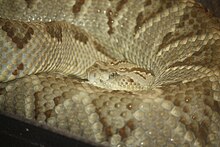Crotalus simus
| Middle American rattlesnake | |
|---|---|

| |
| Yucatán Neotropical rattlesnake (Crotalus simus) | |
| Scientific classification | |
| Domain: | Eukaryota |
| Kingdom: | Animalia |
| Phylum: | Chordata |
| Class: | Reptilia |
| Order: | Squamata |
| Suborder: | Serpentes |
| Family: | Viperidae |
| Genus: | Crotalus |
| Species: | C. simus
|
| Binomial name | |
| Crotalus simus | |
| Synonyms | |
| |
- Common names: Middle American rattlesnake,[2] Central American rattlesnake,[4] tzabcan (local name for subspecies C. s. tzabcan)
Crotalus simus is a
Description
Adults commonly exceed 130 cm (51 in) in length, with males growing larger than females. Large males reach 140–160 cm (55–63 in) in some populations. The maximum length is 180 cm (71 in).[2]
The body has a rough appearance because the
Distribution and habitat
The species is found from
Uses
To the
Venom
Bites are similar to rattlesnake bites in the United States. Local symptoms may be severe, with pain, massive swelling, blistering, and necrosis that lead to fasciotomies and in some cases amputations. Systemic effects involving hemostatic disturbances are rare, as are kidney failure, and neurotoxicity. Only venom from neonates contains crotoxin; a constituent typically found in C. durissus venom that produces neurotoxic symptoms.[6]
Taxonomy
Previously, until 2004, the description for this form was listed as the nominate subspecies for the tropical rattlesnake, C. durissus.[3] Molecular genetic data suggest the taxa culminatus and tzabcan should be considered as separate species from C. simus[7]
References
- . Retrieved 20 November 2021.
- ^ ISBN 0-8014-4141-2..
- ^ ISBN 1-893777-01-4(volume).
- ^ ISBN 0-520-21056-5.
- ^ "Crotalus simus". Integrated Taxonomic Information System. Retrieved 28 August 2007.
- ISBN 0-8014-4141-2.
- ^ Wüster, W., J.E. Ferguson, J.A. Quijada-Mascareñas, C.E. Pook, M.G. Salomão & R.S. Thorpe (2005) Tracing an invasion: landbridges, refugia and the phylogeography of the Neotropical rattlesnake (Serpentes: Viperidae: Crotalus durissus). Molecular Ecology 14(4): 1095–1108.
Further reading
- Sonnini, C.S. & Latreille, P.A. 1801. Histoire naturelle des Reptiles, avec figures dessinées d'après nature; Tome III. Seconde Partie. Serpens. Crapelet. Paris. 335 pp. (Crotalus simus, p. 202.)

